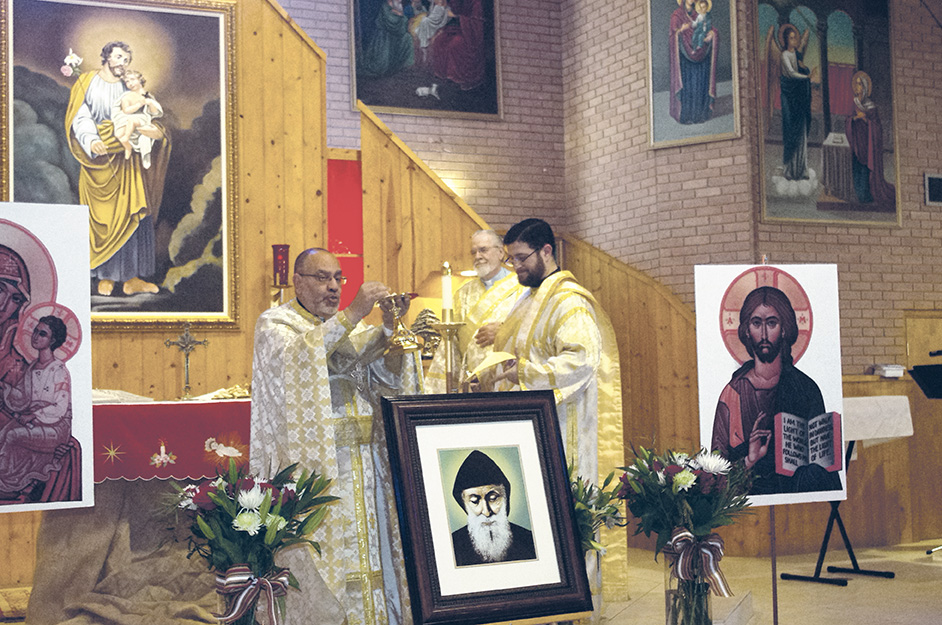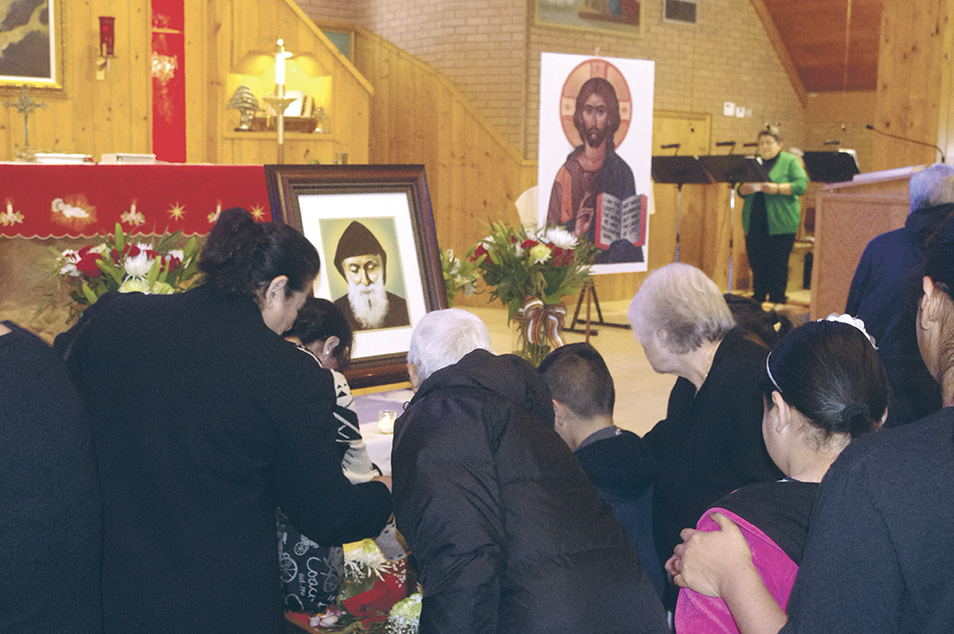
St. Charbel, a humble Lebanese monk from the 19th century, has been credited with thousands of miracles since his death in 1898. Catholics from throughout the Valley descended on St. Joseph Maronite Catholic Church to venerate this saint’s relics Jan. 15-17.
St. Joseph pastor Fr. Wissam Akiki welcomed Bishop Elias Zaidan of the Maronite Eparchy of Our Lady of Lebanon, headquartered in Los Angeles, for a three-day celebration. The relics were on display at the church as part of the 50th anniversary of the saint’s beatification.
St. Charbel was born Youssef Makhlouf in Lebanon and became a monk, taking the name of the martyr, Charbel. The last 23 years of his life were led in total silence and austere penance in a hermitage where he slept on the hard ground. He died on Christmas Eve 1898. Pope Paul VI beatified him in 1965 and canonized him a saint 12 years later.
Faithful from across the Valley and beyond filled in the pews and stood in line at St. Joseph, waiting to venerate the saint’s relics. Standing outside in the brisk morning air Jan. 16, many stopped to examine the table heaped with books, medals and images of St. Charbel. A mixture of Arabic, English and Spanish could be heard as the crowd perused the religious goods and fancied the array of pastries nearby.
Among the 13 separate liturgies celebrated during the three-day extravaganza at St. Joseph were two Masses in Spanish. The largest shrine outside St. Charbel’s tomb in Lebanon is the Basilica of Our lady of Guanajuato in Guanajuato, Mexico, where Lebanese immigrants introduced devotion to him in the early 1900s. Crosier Father Bob Rossi celebrated Mass in Spanish Jan. 15 at St. Joseph.
“I’m very happy to do it because I am close to the Maronite community and know that St. Charbel is at the heart of their spirituality,” Fr. Rossi said. “He has inspired many Hispanic people so he’s an important saint for the Universal Church but especially with Lebanese Catholics.”
Fr. Rossi said that he was amazed to see a statue of St. Charbel at the cathedral in Mexico City when he traveled there. He agreed that devotion to the saint is popular among Hispanics.
“I think it’s because of the numerous miracles that he’s known for,” Fr. Rossi said. “I think the Hispanic community is drawn to that kind of spiritual power.” Indeed, miracles attributed to the saint’s intercession are recorded across the Middle East as well as South America, Australia, Russia, Europe and in the U.S.

Joseph Chemary, an usher at St. Joseph, said he’s called on the intercession of the saint many times, most notably for his children.
“My son, he had asthma. No more asthma,” Chemary said. “My son, he used to do drugs big time. No more drugs. Thank God. It is great — more than great. I believe he is the most powerful saint we ever had.” His daughter, Chemary added, passed her nursing board exams with the help of St. Charbel’s intercession.
Huda Chaer, another parishioner at St. Joseph, said she’d suffered from ulcerative colitis for 18 years. She said her prayers were answered when she asked for St. Charbel’s assistance.
“I’ve been very sick. I went through a lot last year and I had a blessing from St. Charbel. Thank God, I am up on my feet again,” Chaer said.
Peter Weingarten of Our Lady of Perpetual Help Parish in Scottsdale was on hand Jan. 15 to venerate the relics too. He remembers when the relics of St. Thérèse of Lisieux came to Phoenix years ago.
“It’s not often you get these relics coming around. It’s once in a lifetime — it’s historic. More Catholics should be out here right now,” Weingarten said.
Fr. Akiki emphasized that while the relics of the humble saint of Lebanon drew many to the church, God is the one to be worshipped.
“The Eucharist is very important. Why are we celebrating Divine Liturgy every two hours? It’s all about Christ, our life,” Fr. Akiki said.
Fr. Peter Boutros, pastor of St. John of the Desert Melkite Catholic Church, offered the morning liturgy Jan. 16. The Mass featured the reading in which Christ asks Peter three times, “Do you love Me?” Fr. Boutros zeroed in on that message in his homily.
“That question is asked to each and every one of us and to every Christian on the face of the earth,” Fr. Boutros said. “We cannot just say yes and go our separate ways. We have to say yes by action, by feeding each other, taking care of each other, by loving each other.”






